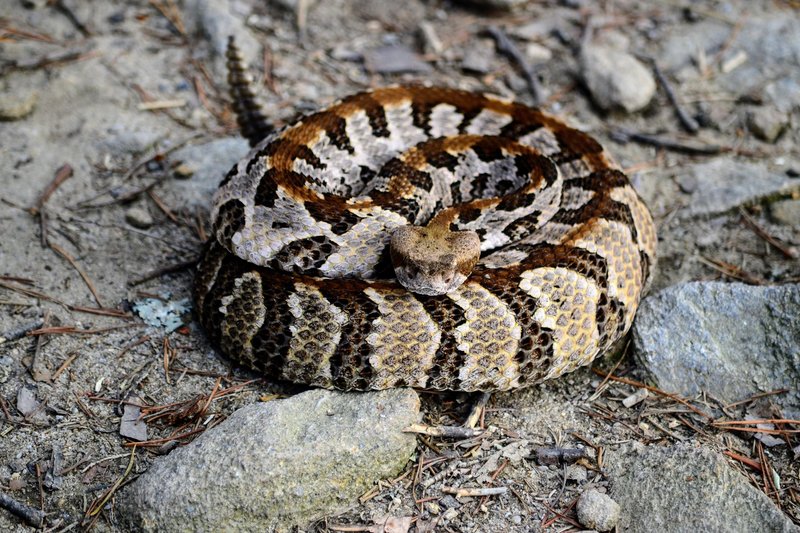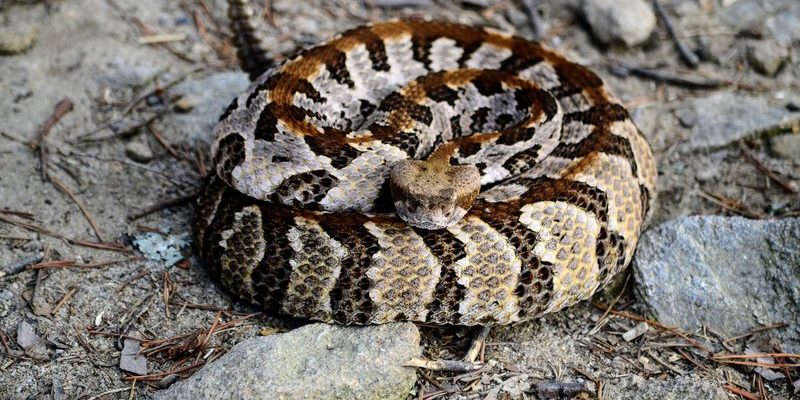
The Timber Rattlesnake is not just another snake; it’s a fascinating creature that plays a crucial role in its ecosystem. Imagine walking through a dense forest, the air thick with the scent of pine and earth. Suddenly, you hear a distinctive rattle—a warning that signifies you’re near one of these remarkable reptiles. Known scientifically as Crotalus-horridus, the Timber Rattlesnake can be both awe-inspiring and intimidating. Understanding its behavior, habitat, and importance can deepen our respect for these creatures and the wild places they inhabit.
You might be wondering, what makes the Timber Rattlesnake so special? These snakes are not only known for their iconic rattle but also for their adaptability and unique physiological traits. They are essential predators, helping to maintain the balance of small mammal populations in their habitats. Yet, they remain misunderstood by many, often facing threats from habitat destruction and human conflict. Let’s dive into the world of the Timber Rattlesnake and learn about its life.
Physical Characteristics
The Timber Rattlesnake features a striking appearance that makes it easily recognizable. Typically, these snakes have a long, robust body that can reach lengths of up to 5 feet. Their coloration ranges from a muted yellowish-tan to dark brown, adorned with distinctive dark bands that help them blend seamlessly into their forested surroundings. This natural camouflage is an essential part of their hunting strategy, allowing them to ambush unsuspecting prey.
One of the most notable features is, of course, their rattle. Located at the end of the tail, the rattle serves as a warning to potential threats. Each time the snake sheds its skin, it adds a new segment to its rattle, making it a unique identifier of age. However, it’s a myth that a rattlesnake’s rattle can reveal its exact age. Instead, some snakes may lose rattles or even have broken ones due to environmental wear.
In terms of sensory capabilities, Timber Rattlesnakes possess heat-sensing pits on their faces. These pits help them detect the body heat of their prey, typically small mammals like mice and rabbits, especially in low-light conditions. This adaptation is crucial for survival, particularly since they are largely ambush hunters. They remain motionless, waiting for the perfect moment to strike.
Habitat and Distribution
Timber Rattlesnakes are primarily found in the eastern parts of the United States, ranging from the southeastern states all the way up to the northern regions, including parts of New England. They prefer habitats that provide ample cover, such as dense forests, rugged hills, and even swamps or wetlands. This variety allows them to thrive in different environments while still having access to their essential needs like shelter and hunting grounds.
During the warmer months, you might find them basking in the sun on rocks or logs, but they are also adept at hiding in leaf litter or underbrush when threatened. As temperatures drop in the fall, Timber Rattlesnakes will seek out hibernation dens—places like rock crevices or burrows where they can stay safe from the cold. These dens can sometimes be communal, where multiple snakes will share the same space during winter.
Human activity has significantly impacted their habitats. Urban development, logging, and agricultural practices have led to fragmentation and loss of their natural environments. Conservation efforts are essential to ensure that Timber Rattlesnakes can thrive in their native habitats for generations to come.
Diet and Hunting Behavior
The diet of the Timber Rattlesnake primarily consists of small mammals, including rodents such as mice, voles, and sometimes even young rabbits. They rely on their excellent camouflage to remain hidden while they ambush their prey. Using their powerful bodies, they can strike swiftly, delivering a bite that injects potent venom, which ultimately immobilizes their catch.
Speaking of venom, it’s worth noting that Timber Rattlesnake venom is hemotoxic, meaning it primarily affects the blood and tissues of their prey, leading to rapid incapacitation. This adaptation enables them to take down prey larger than themselves. After a successful strike, the snake will typically wait for a short while before consuming its meal, allowing time for the venom to take effect.
Interestingly, these snakes have a unique way of eating. Unlike some reptiles that swallow their prey whole, Timber Rattlesnakes swallow their food headfirst. This helps them manage the size of their meals better, preventing any potential choking or complications while eating. They don’t need to eat very often, as they can go weeks or even months without a meal, depending on their size and the availability of food.
Behavior and Social Structure
Timber Rattlesnakes are primarily solitary creatures, preferring to live alone except during mating season. As cold-blooded reptiles, their activity is largely influenced by temperature. You’ll find them basking in the sun during warmer days but becoming less active during the cold. Their social interactions are minimal, but during mating season, males will compete for females by engaging in ritualistic combat. This is where two males will entwine around each other, trying to gain dominance, displaying both strength and agility.
During the day, the Timber Rattlesnake typically stays hidden, emerging at dusk as it begins to hunt. Their keen senses come into play at this time, allowing them to detect even the slightest movements in their environment. An interesting aspect of their behavior is their use of hibernation dens. These sites often become social hotspots during the colder months, as multiple snakes will gather in communal hibernacula, seeking warmth and safety.
It’s crucial to remember that Timber Rattlesnakes are not aggressive creatures by nature. They would rather avoid confrontation than strike. If they feel threatened, they’ll often rattle their tails as a warning, giving potential threats a chance to back away before they resort to using their venom.
Reproduction and Lifespan
When it comes to reproduction, Timber Rattlesnakes have a unique mating season that usually occurs in the spring after they emerge from hibernation. Males will actively seek out females, and after mating, females will typically give birth to live young, a fascinating trait not common in all snakes. A female can give birth to anywhere from 6 to 20 young snakes, which are immediately independent and must fend for themselves.
The young Timber Rattlesnakes are miniature versions of adults, complete with their own rattles, but they tend to be more vulnerable due to their small size. They rely on their camouflage to evade predators, including birds of prey and larger snakes. The survival rate for young Timber Rattlesnakes can be quite low, with many succumbing to various environmental pressures.
As for lifespan, Timber Rattlesnakes can live quite a long time, often reaching 15 to 20 years in the wild, and sometimes even longer in captivity. Their longevity can be affected by various factors, including habitat quality, food availability, and human-related threats. With the right conditions, these snakes can thrive and contribute to the ecological balance for decades.
Conservation Status and Threats
The Timber Rattlesnake is classified as a species of concern in many regions due to habitat loss, hunting, and road mortality. Conservation efforts are essential to ensure their survival. Many states have put laws in place to protect these snakes and their habitats, recognizing their ecological importance as apex predators.
Public education is also a key factor in conservation. Misunderstandings about Timber Rattlesnakes often lead to unnecessary killings. Many people fear these snakes and may harm them at the first opportunity. Education campaigns can help foster a better understanding of their role in nature and reduce conflicts between humans and rattlesnakes.
In addition to education, habitat restoration and protection initiatives are vital. Preserving the natural environments where Timber Rattlesnakes thrive ensures they have the resources they need to survive. Organizations dedicated to wildlife protection often work on creating safe corridors that allow these snakes to move between habitats without the threat of human intervention.
Interesting Facts About Timber Rattlesnakes
| Common Name: | Timber Rattlesnake |
| Scientific Name: | Crotalus horridus |
| Length: | Up to 5 feet |
| Habitat: | Forests, hills, swamps |
| Diet: | Small mammals, birds |
| Venom Type: | Hemotoxic |
| Average Lifespan: | 15-20 years |
FAQ
What should I do if I encounter a Timber Rattlesnake?
If you encounter a Timber Rattlesnake in the wild, it’s best to remain calm. Back away slowly and give the snake space to move. Rattlesnakes typically prefer to avoid humans and will move away if they feel there’s no threat. Avoid trying to handle or kill the snake, as this can lead to dangerous outcomes for both you and the snake.
Are Timber Rattlesnakes dangerous to humans?
While Timber Rattlesnakes are venomous, they are not inherently aggressive. Most bites occur when a person accidentally steps on or provokes them. If bitten, seek medical attention immediately. Antivenom is available and is effective if administered promptly. Remember that these snakes play an important role in their ecosystems, and understanding them can reduce the risk of conflict.
How can I identify a Timber Rattlesnake?
To identify a Timber Rattlesnake, look for their characteristic rattles, which can be heard when they feel threatened. They have a stocky body, a broad head, and distinctive dark bands against a lighter background that helps with camouflage. Heat-sensing pits on their faces are another identifying feature that helps them hunt in low light.
Where do Timber Rattlesnakes hibernate?
Timber Rattlesnakes hibernate in dens, which can be crevices, rock piles, or burrows. These dens are often communal, allowing multiple snakes to share the space, which helps them retain heat during the cold months. After hibernation, they emerge in spring to search for food and mates.
What is the significance of the Timber Rattlesnake in its ecosystem?
The Timber Rattlesnake is a vital predator that helps control the populations of small mammals, contributing to a balanced ecosystem. By keeping these populations in check, they help prevent overgrazing of plants, supporting overall biodiversity in their habitat.
Can Timber Rattlesnakes be kept as pets?
While some people may be interested in keeping Timber Rattlesnakes as pets, it’s important to understand that they require specialized care and environments. Ownership of venomous snakes is regulated in many areas, and it’s crucial to have proper knowledge and resources before considering one as a pet. It’s often better to appreciate these creatures in the wild where they belong.
What do Timber Rattlesnakes do in the winter?
In winter, Timber Rattlesnakes enter a state of brumation, similar to hibernation. They seek out dens where they can safely remain until temperatures rise again in spring. During this time, their metabolism slows down, and they do not actively hunt or feed.
How long do Timber Rattlesnakes live?
Timber Rattlesnakes can live quite long, often reaching between 15 to 20 years in the wild. Lifespan can be influenced by a variety of factors, including environmental conditions, availability of food, and threats from predators or humans.
Are there any conservation efforts in place for Timber Rattlesnakes?
Yes, there are various conservation efforts aimed at protecting Timber Rattlesnakes. Many organizations work to preserve their habitats, promote public education about their ecology, and establish legal protections to prevent unnecessary killings. Awareness and understanding can significantly contribute to the survival of this important species.
What is their role in controlling pests?
Timber Rattlesnakes are crucial for controlling populations of rodents and other small mammals that can become pests in agricultural areas and other environments. By preying on these animals, they help maintain a natural balance, reducing the chance of overpopulation and the potential spread of diseases.

